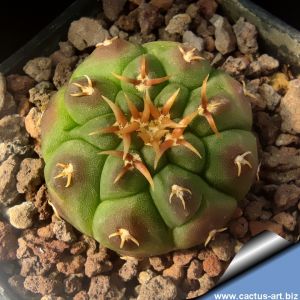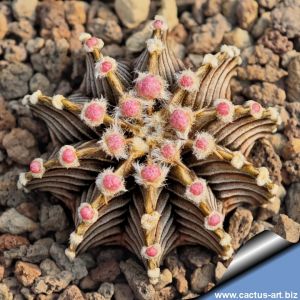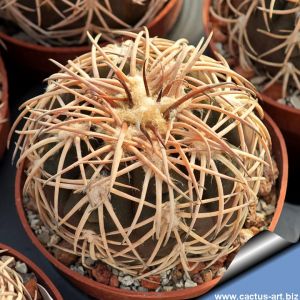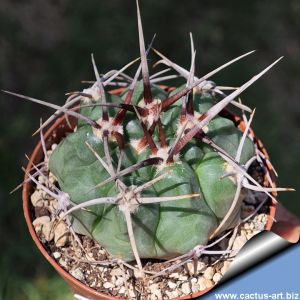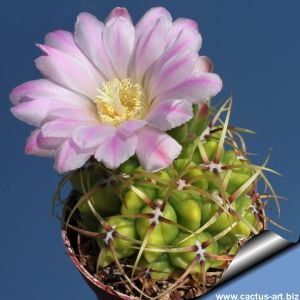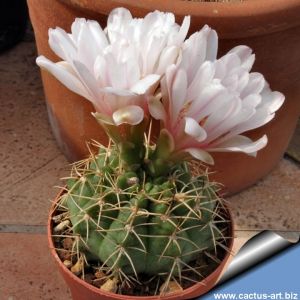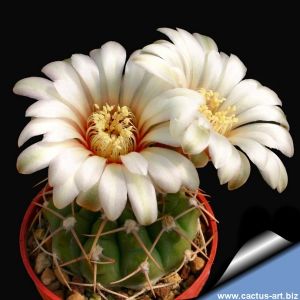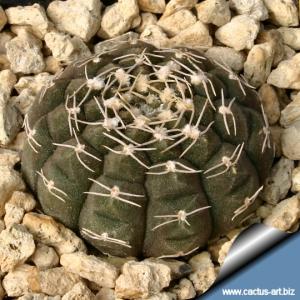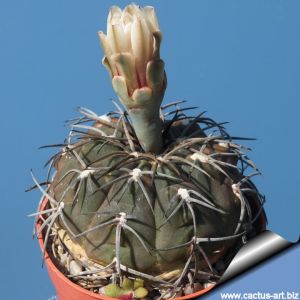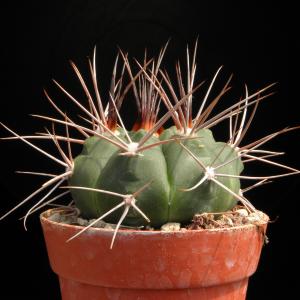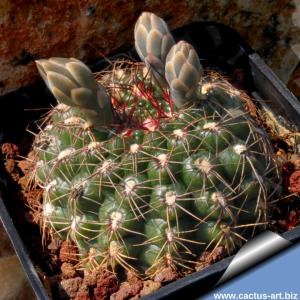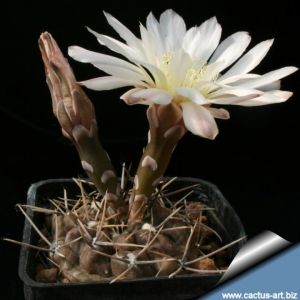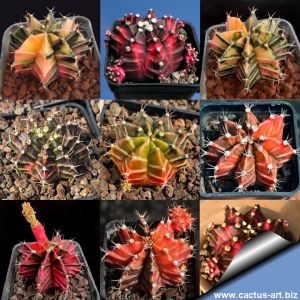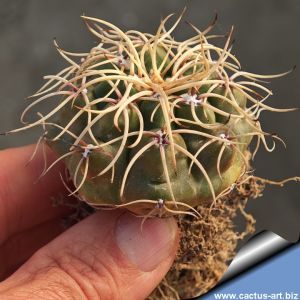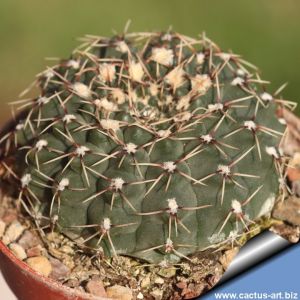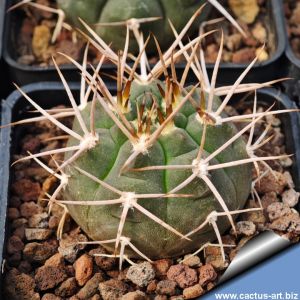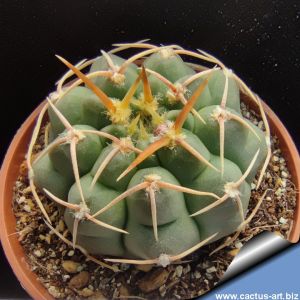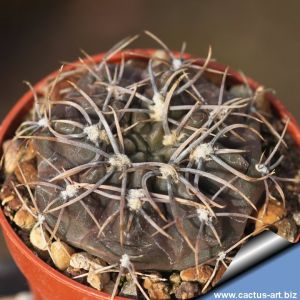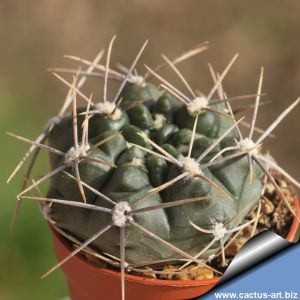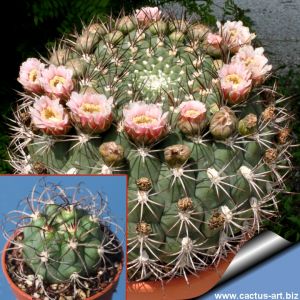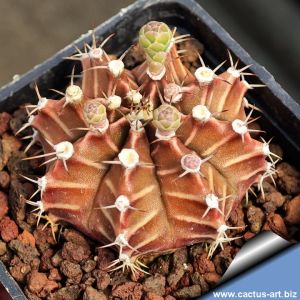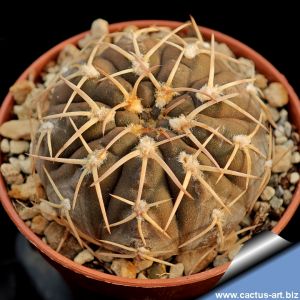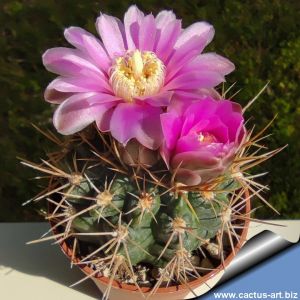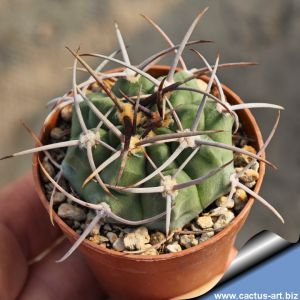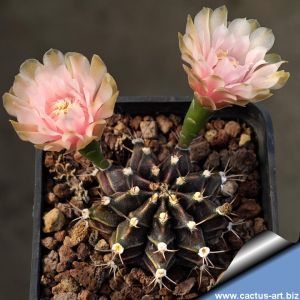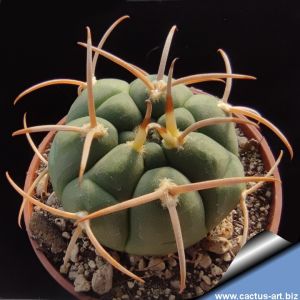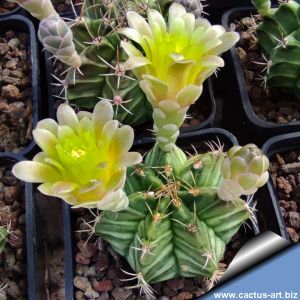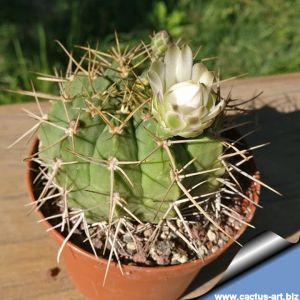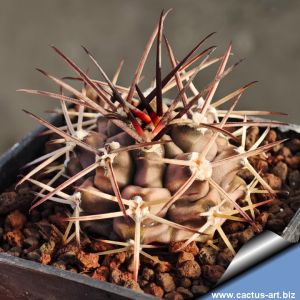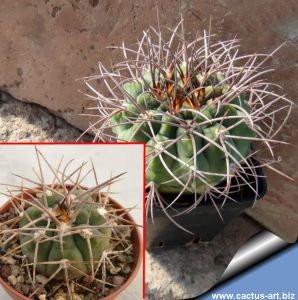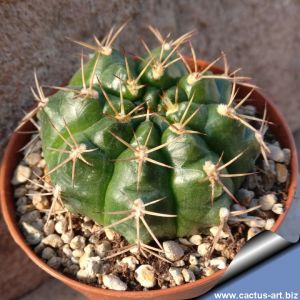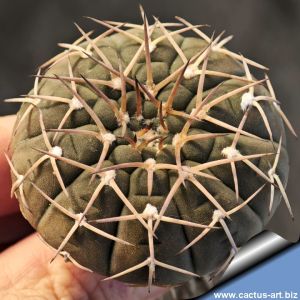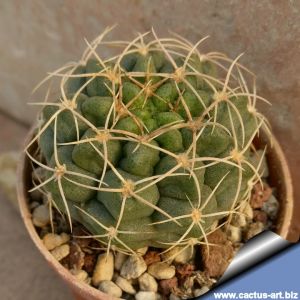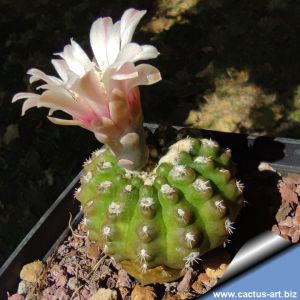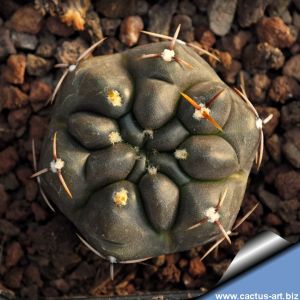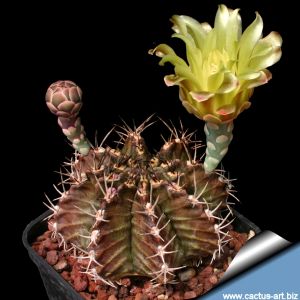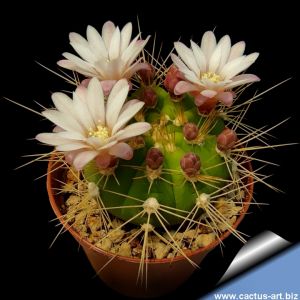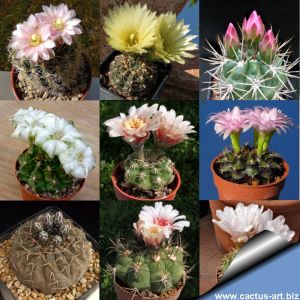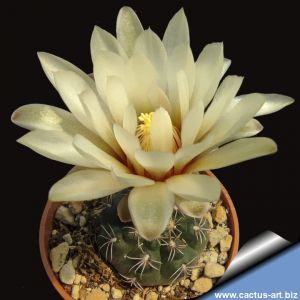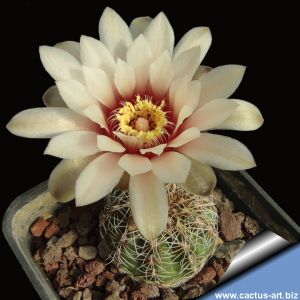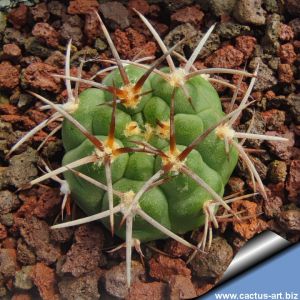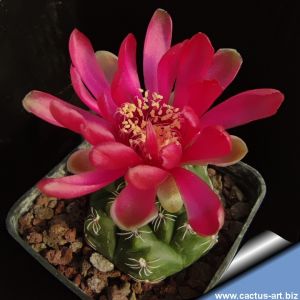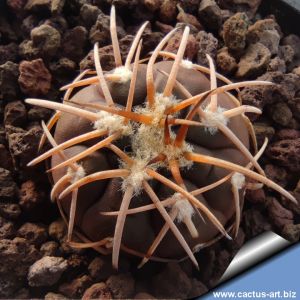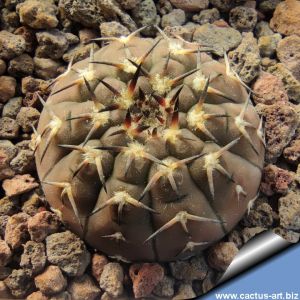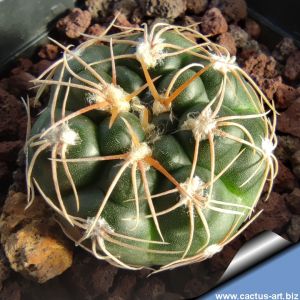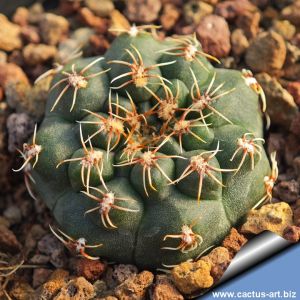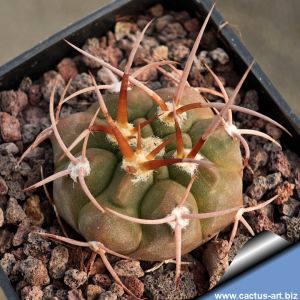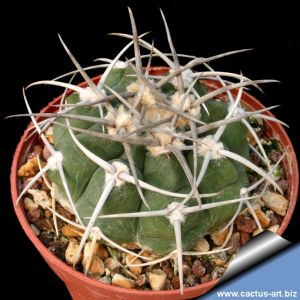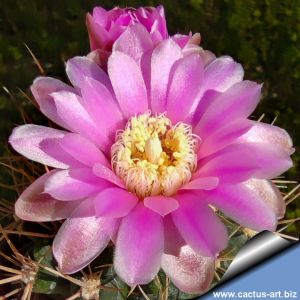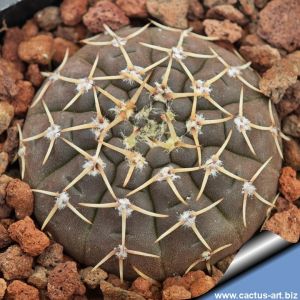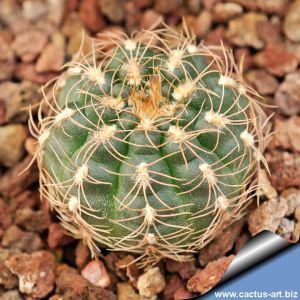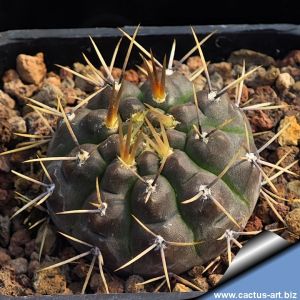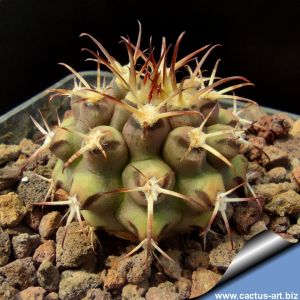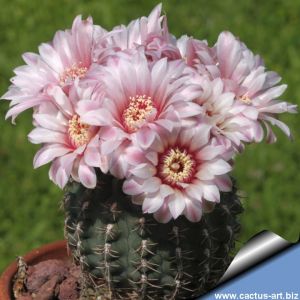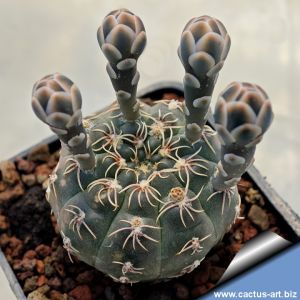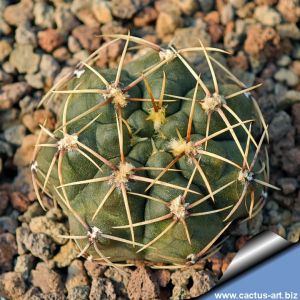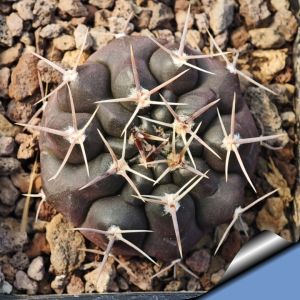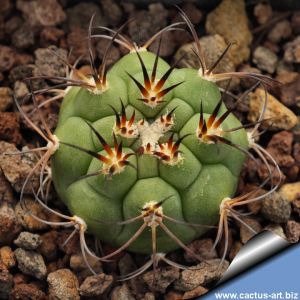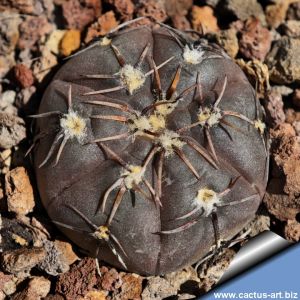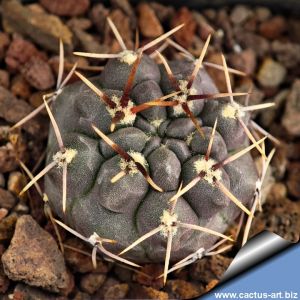-
1
G. calochlorum v. proliferum is a clustering cactus forming low, flat-topped clusters of many stems that grow level to soil. The spines are wispy and creamy white to brown. The light pink flower is trumpet shaped with curved petals and open completely.
-
2
A rare form of G. vatteri, easily recognized by its three short, thick, ivory-coloured spines per areole, elegantly bent downward and outward, reminiscent of an eagle’s talons.
-
3
A remarkable plant featuring ribs with delicate lines that transition from creamy white to green, and even to a very dark purple. During winter, the colors shift to warmer hues like cream, ochre, and mahogany. Absolutely stunning.
-
4
Exceptional plants grown in Ø 6.5 cm pots, cultivated in full sun and showing stunning spination. Flattened, dark brown body with recurved, downward-pointing spines closely appressed to the stem. An opportunity not to be missed!!!
-
5
-
6
Green, spherical-flattened stem with 13-15 ribs and pointed tubercles. It has 5-7 sturdy, imposing spines per areola. The real show comes when the large pink flowers with a deep red center appear: a perfect wonder for any succulent love
-
7
Strongly spined and hardy species from Argentina with long stiff yellow translucent spines with a red base on a bright green background. This is one of the most admired species in cactus collections.
-
8
Flat dull green body, ribs with tubercles, very nice pinkish flower!
-
9
Nice slow growing species, stem flattened, spines addpressed agaist the stem of the plant. Generally solitary but old specimens may cluster from the base.
-
10
A slow-growing, nearly disc-shaped stem, extremely flattened and scarcely emerging from the soil, displaying hues from greenish-grey and dull olive to purplish-brown and almost brick-red. Produces clustered white flowers from June to September.
-
11
A slow-growing solitary cactus with an olive-green, greyish or brown stem, flattened at the apex. Long, rigid spines point sideways or downward, lying close like armour. Flowers are cream or pinkish-white with a reddish throat.
-
12
-
13
-
14
-
15
Variegated wonders from seed! Thai parents give each specimen unrepeatable patterns and hues—no two plants are alike. Each is a unique living artwork with its own personality.
-
16
Gray-green or slightly bronzed epidermis with barely pronounced tubercles. Typically bears 5 (occasionally 6) very pale beige spines, downward-curving and somewhat twisted; in full sun, they become long and sturdy.
-
17
-
18
-
19
A slow-growing solitary cactus with flattened, muted grey-green or blue stems. Only three recurved spines bent tightly to its body - nature's lesson in economical beauty.
-
20
-
21
-
22
A solitary Gymnocalycium that grows to impressive dimensions. The most surprising trait? Wet spines flush bright red, producing a dramatic and temporary color display that fascinates collectors.
-
23
A mix of surprises! These hybrids boast sharp ribs in gray-green, sometimes with brown, purple, and light bands. Their flowers? A color palette from greenish-white to bright pink! Each plant is uniquely unpredictable.
-
24
Short grey-brown, downward facing spines. Flattened body, olive-green to brown. Limited numbers available!
-
25
-
26
-
27
Hybrids with gray-green to olive ribs (occasionally brownish or purple-tinged) and pale transverse bands. Flowers range from greenish-white to deep pink, with intermediate shades.
-
28
Striking grey and brown banding on a matte olive-green stem. Charming yellowish-green blooms.
-
29
Globose-flattened stem in blue-grey green, bearing a taproot and 3 to 5 stout, curved spines.
-
30
This plant’s most unique haracteristic is its colourful body ( greyish-green to browish-purple with white and red highlights). The flowers have a silky appearance and range from pale green to brownish-yellow.
-
31
-
32
Large pink flowers, five very broad ribs, and strong yellow spines. It clumps readily and grows quickly.
-
33
A remarkable Gymnocalycium, admired for its beauty and uniqueness. It has pronounced tubercles ranging from olive green to grey-pink, but its most striking feature are its long, sturdy, sharply pointed spines.
-
34
Gymnocalycium nidulans distingushes for the dense covering of stout grey interlacing spines. The plants typically got a dull brownish-green body colour and is one of the most decorative cacti of the genus Gymnocalycium.
-
35
-
36
This Gymno dazzles with translucent, amber-yellow spines shaped like curved tusks—dark at the base and glassy at the tips—sentry over its vibrant green body. Its dramatic spines appear hand-carved from amber, making it a perennial showstopper.
-
37
-
38
Gymnocalycium stellatum is a beautiful slowly growing cactus. The stem is noticeably flatten dark greyish-brown to olive coloured. Spines 3, yellow to brown, becoming grey with age, add-pressed straight to slightly curved and flattened against the stem.
-
39
-
40
-
41
Compact and distinctive cultivar with ribs divided into small tubercles and very short spines that define its uniqueness. This specific structure creates a characteristic look that stands out clearly.
-
42
Gymnocalycium gibbosum var. chubutense distingushes for the unusual dark green to nearly black stem and for the cream-white or pinkish flowers. In its habit during winter there are heavy snows and frosts can occur throughout the year.
-
43
Gymnocalycium mihanovichii v. filadelfiense is usually solitary. The stem is dark bronze-green with sharp ribs more or less striped with white up to be 4 cm talland 5-6 cm in diameter. The flowers are greenish/tan o pink and silky-shining.
-
44
Gymnocalycium chacoense is a highly interesting species, distinct from others in the genus, with straight, golden, bristly spines giving it a unique look. Flowers are white or pinkish. Forms large clusters as it matures.
-
45
Mix of Gymnocalycium species, hybrids, and seed-grown cultivars - Each plant is unique, with different shapes and colors. A very interesting selection at an affordable price, perfect for those who want to start or expand their collection.
-
46
Flattened spherical body, olive-green or dark gray-green. White areoles with short, appressed spines pointing downward. Large cream-colored flowers with red throats, produced abundantly even on young plants.
-
47
Short cylindrical stems with many dirty white spines, dark body, white-pink flower with reddish throat.
-
48
Beautiful species with dark green body. Few stout, slightly bent spines. Bears short red flowers, striking despite their size.
-
49
Red flowers.
-
50
Special selection. Stunning spines, long and elegantly bent downward. One of the most beautiful forms available.
-
51
Very big light yellow flower!
-
52
Very flattened chocolate brown body. Three short spines per areole appressed to the stem. Very nice but slow growing.
-
53
Globose black/purple greyish-brown body. Black to brownish spines, that became whitish-grey with a black base as they age. Flowers creamy white with a shade of pink or red
-
54
Flat and groupforming, pectinate spines, white-pink flower with red throat.
-
55
Small dark coloured body, short spines and pretty light pinkish flower.
-
56
Flattened brown body adorned with short, stout spines. The pristine white flowers create a striking visual contrast against the dark-toned plant body.
-
57
-
58
Very nice new species with pink fl on spiny plants. Huge taproot.
-
59
Disc-shaped to hemispherical stem, often flattened. Brownish-grey to brown-green epidermis, with pearl-white fragrant flowers and 3 short claw-like spines. A uniquely elegant cactus.
-
60
Tiny grey body, pinkish spines, long white-pink flower.
-
61
Small flat body with few white spines, nice white-pink flower with reddish throat.
-
62
It grows in the same area of Lobivia ferox, Lobivia huascha, Tephrocactus alexanderi, Tephrocactus articulatus, Echinopsis leucantha and Gymnocalycium schickendantzii.
-
63
Slow-growing flattened-globose body with slight apical depression, featuring prominent ribs. Coloration ranges from deep olive-green to matte grey-green. Straight radial spines, cream-white with darker bases. Silky white funnel-shaped flowers.
-
64
This is a particularly unusual species, unlike any other. Each tubercle bears a mahogany spot in a V or U shape at its base. A striking detail that makes it very beautiful.
-
65
Extremely flat-growing Gymnocalycium, barely rising above soil level. Features attractive short spines and body color ranging from reddish to dark bluish-green. Flowers fade to pale pink to white when fully open, displaying a distinctive red throat.
-
66
Cream-colored, spider-like spines sprout from large luminous areoles, weaving an nice pattern across the olive green plant’s body. A delicate and elegant contrast, a cactus with refined, unusual aesthetics.
-
67
Gymnocalycium taningaense features a small body that barely emerges from the ground, solitary but often branching at the base in cultivation. It is distinct from G. calochlorum due to its yellow flower throat (red in calochlorum) and narrower flower tube.
-
68
Tuberculate ribs bearing stout, long terete spines. Matures into an impressive specimen over time, developing a commanding presence that becomes the centerpiece of any collection.
-
69
-
70
Beautiful thick plants.
-
71
A flattened, bronze-brown-bodied cactus with closely pressed, downward-pointing spines. Among the most beautiful Gymnocalycium species, admired for its refined form and striking coloration.
-
72
Dark green to near black stems with stout spines evolved for Patagonian extremes. White flowers create stunning contrast. Remarkably winter hardy (Winterhart), ideal for cold climate and even for rock gardens.


